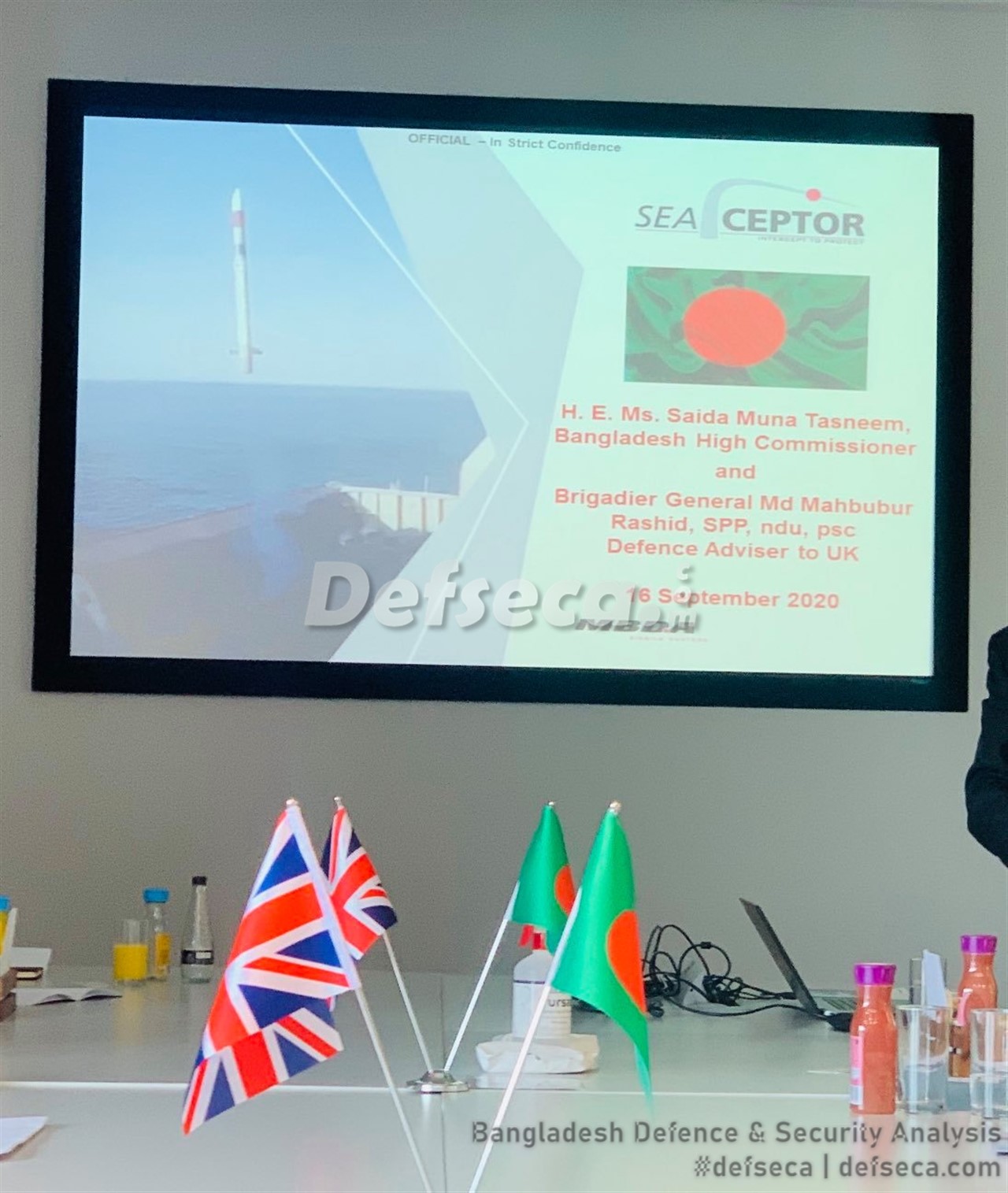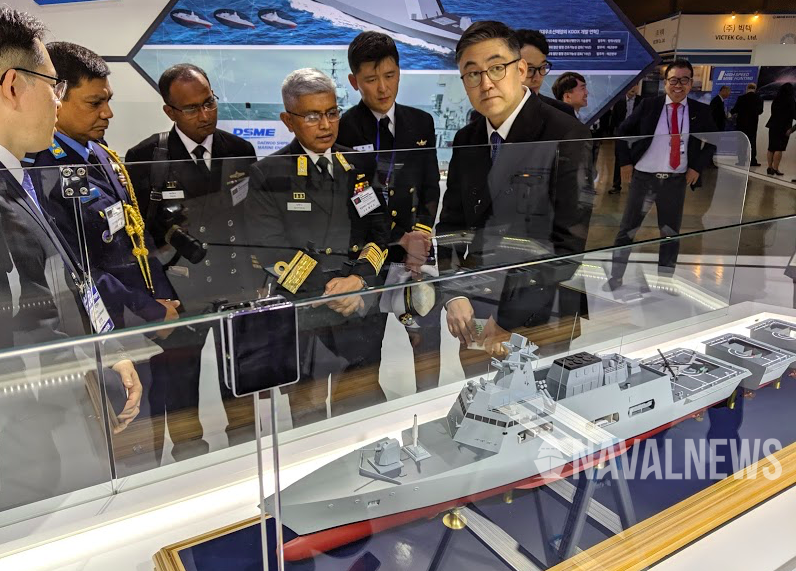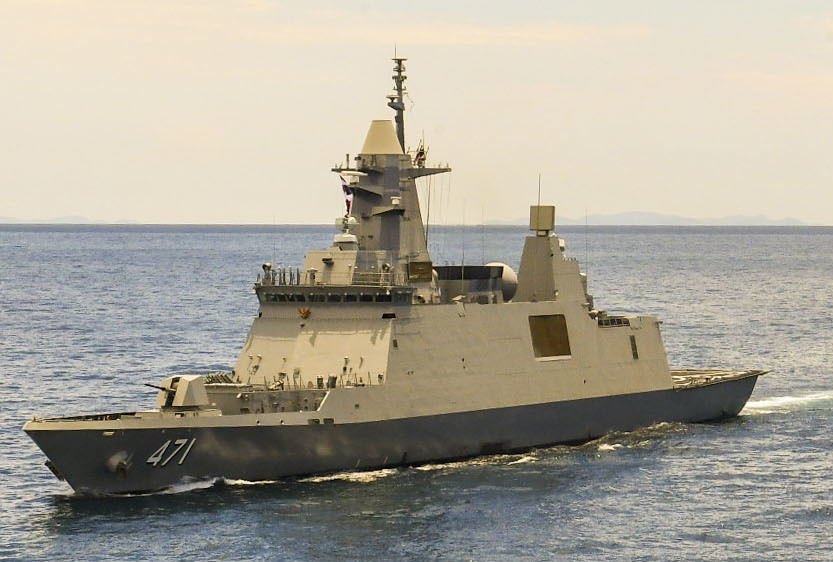From buyer to builder
In order to build the big warships, equipped with modern equipment and devices, Prime Minister Sheikh Hasina recently gave her approval in principle, sources in the Bangladesh Navy and CDDL said. CDDL expects to start the construction of the warships from the end of this year. It would likely to build the warships in cooperation with foreign warship-building companies under the joint venture (JV) system, the sources added.
As part of the implementation of the Forces Goal 2030, the Navy will build the six warships at a time when the naval force has recently become a three-dimensional force.
The CDDL Managing Director, Commodore Mohammad Nazmul Karim Kislu, told The Independent recently that some foreign warship-building companies—including those from Italy, the Netherlands and France—have evinced interest by sending proposals to build the frigates, each under joint venture (JV) arrangements.
“We are scrutinising their (foreign companies’) proposals. We will invite tenders for constructing the frigates after their proposals are finalised,” he said.
“We will build the frigates in three phases. Two frigates by 2022, two others by 2025 and the remainder within 2030, as per the master plan of the naval force,” he added.
Commodore Kislu added that CDDL plans to start construction of two of the frigates within this year. The MD of CDDL disclosed that it will construct the warships under a joint venture or a government-to-government (G-to-G) deal with reputable warship-building foreign companies that have better experience in building frigates.
He added that they will build the proposed big warships with 30-year lifetimes each. They would be well equipped, with modern military hardware and devices, so that the frigates can operate smoothly during their operations.
Commodore Kislu, a senior officer of the Navy, said that officers at the chief executive officer (CEO) level have visited, with technical teams, the site where the proposed warships would be constructed.
“We have the necessary spaces and manpower for support the construction of any big warship, the brand of which will be ‘Made in Bangladesh’. We have also a big dockyard. We are setting up a bid design house to design the warships,” he said.
He also disclosed that a ‘ship testing toeing tank’ will also be built at the CDDL.
The naval commodore said there are plans to also build merchant ships in future, after constructing the warships.
While addressing a function of the President Parade at the Bangladesh Naval Academy on December 24 last year, Prime Minister Sheikh Hasina, who is also the defence minister, had expressed her hope that the Navy would be able to export warships. “We will be able to turn Bangladesh Navy into a Builder Navy from Buyer Navy gradually, and we ourselves can export warships Insha Allah,” she had said.
In November last year, two submarine destroyers—large patrol craft—Durgam and Nishan, built in Khulna Shipyard, were commissioned in the naval fleet.
There are three shipbuilding workshops—Chittagong Dry Dock Ltd, Khulna Shipyard and Dockyard and Engineering Works Ltd in Narayanganj—currently operating under the Navy.
CDDL is the only dry dock in Bangladesh, located on the bank of the Karnaphuli on 48 acres of land within the Chittagong Port area. The dry dock was designed and constructed in the late 1960s with the help of technical assistance from the then Yugoslavia. It came into commercial operation in July 1985.
CDDL can perform a wide range of medium to heavy engineering works to support local industries, including complete vessel renovation and conversions.
Over the years, CDDL has successfully completed countless repairs and maintenance of commercial vessels of various sizes and types, including warships of the Navy and ships of the Bangladesh Shipping Corporation and the Chittagong Port Authority (CPA). CDDL is now constructing container vessels for the Bangladesh Inland Water Transport Authority (BIWTA).
CDDL is now an ISO 9001:2015 certified company for ship design and shipbuilding (both warships and commercial vessels). This is a licensed company for exporting new ships and products.
On December 23, 2015, Prime Minister Sheikh Hasina handed over CDDL to Bangladesh Navy as its enterprise. Earlier, it was an enterprise of the Bangladesh Steel and Engineering Corporation (BSEC), a state-owned organisation.
The Navy has prepared a master plan to spend thousands of crores to ensure the security of the country’s 1,18,813 sq. km of sea territory.
The Navy has long-term plans to build ships in the naval yards for various maritime agencies of Bangladesh to secure her maritime interests as well as to make forays into shipbuilding to support the government for attaining the Sustainable Development Goals and the Blue Economy in future.
Frigates are considered the workhorse of modern navy and the smallest of the ships able to operate in oceans alongside other large warships and carrier groups.
The key roles of frigates are guarding other battle or merchant ships and primarily divided into three categories: Anti-ship, Anti-submarine warfare (ASW) and Air Defence (Guided Missile Frigate). Manned usually by about 150 to 200 crews, these ships are seen to have displacements between 2,000 to 5,000 tonnes. Frigates are comparatively fast, with speeds in the range of 25-30 knots and operating range of 5,000-15,000 miles.
All modern frigates carry air/surface search radar, guidance radar and active, passive sonars as well as electronic warfare and countermeasure equipment. Frigates are powered by diesel/diesel-electric engines and usually carry 1 or 2 helicopters for anti-submarine warfare and search & rescue operations. Bangladesh Navy currently operates seven frigates including two US-made, three China-made and one made in South Korea.

From buyer to builder
For the first time in the country, Bangladesh Navy is going to build six big frigates (naval warships) so as to become a self-reliant marine force in the region. The frigates would be constructed by its enterprise, the Chittagong Dry Dock Ltd (CDDL). In order to build the big warships, equipped...
Building warships locally
The Chittagong Dry Dock Ltd (CDDL) has started the process of building six big frigates for the Bangladesh Navy. Already, 12 international shipbuilding companies have expressed interest to CDDL—an enterprise of Bangladesh Navy—to jointly build the frigates.CDDL authorities are now scrutinising the proposals, with an aim to start construction work within this year.
Of the 12 overseas ship-building companies, one company from Italy—Fincantieri, French shipbuilding company STX, Damen Shipyards from Denmark, two UK-based companies—Cammell Laird shipyard and Babcock International, two Chinese shipbuilding companies—China Shipbuilding and offshore International Co. Ltd. (CSOC) and China Shipbuilding Trading Co. Ltd. (CSTC), and two Indian companies— Reliance and Garden Reach Shipbuilders and Engineers Ltd, Singapore’s Singapore Technologies Marine Ltd, and three South Korean shipbuilders—Daewoo, Posco Daewoo Corporation, and Hyundai, have expressed interest to build the frigates.
For building these big warships with modern equipment and devices, Prime Minister Sheikh Hasina has recently given her approval-in-principal (AIP).
Time frame
Mohammad Nazmul Karim Kislu, the managing director (MD) of CDDL Commodore, told The Independent that the company was asked by the Bangladesh Navy to build the six frigates, to implement the Vision 2030 plan of building a three-dimensional force.
“We expect to start constructing the ships within this year, in cooperation with foreign warship-building companies, under the joint-venture system,” he said.
“We are scrutinising the initial proposals and we will invite tender for constructing the frigates, after finalising the proposals,” he added.
“Some of the overseas shipbuilders have submitted financial proposals to us. We are hoping that the rest will submit their financial and technical proposals within the shortest possible time. We will then prepare a short list of the companies,” the CDDL MD said.
“We will build the frigates in three phases—two frigates by 2022, two more by 2025, and rest within 2030, as per the master plan of the naval force,” he added.
Commodore Kislu confirmed that CDDL plans to start building the first two frigates within this year.
Joint venture
The CDDL MD disclosed that the warships will be built under a joint venture or government-to-government (G2G) deal, with the reputed warship building foreign companies. He informed that the frigates will have a 30-year lifespan each.
Commodore Kislu, a senior officer from Bangladesh Navy, said that C-level officials of the interested overseas shipbuilding companies, along with their technical teams, have visited the site where the warships would be constructed.
“We have the required space and manpower for constructing big warships. We also have big dockyards. We are setting up a design house to design the 'Made in Bangladesh' warships,” he said.
He informed that they will also build a ‘ship-testing towing tank’ at the Chittagong Dry Dock Limited.
“After meeting the demand of Bangladesh Navy, we will start building frigates for other countries,” Commodore Kislu said. He said CDDL also has plans to build merchant ships in future.
At present, CDDL is engaged in building new ships, pontoons and mooring buoys. The navy enterprise is also manufacturing all types of steel structures of various industries, and is into fabrication of portable steel bridges. It also undertakes engineering work related to repair and maintenance of various port facilities. The public sector company also imports steel and ship-building raw material for own consumption, as well as the domestic markets.
CDDL profile
The CDDL is an ISO 9001:2015 certified company for ship design and shipbuilding (both warships and commercial vessels). It has license for exporting new ships and products. It is re-engining/repowering/major renovation of machinery, equipment of all types of vessels. CDDL is a member of the Chittagong Chamber of Commerce.
CDDL is a profitable industry and fulfilling its annual target for the last two consecutive years. The company carries out huge welfare for the employees which includes incentive bonus, food, treatment, uniform, safety gears, easy term loans, Hajj etc. The company also takes care of its employees' families with funds for children's education, scholarships, and healthcare and housing facilities.
Bangladesh being a maritime and riverine country, there is a huge demand for ships and large vessels. At present, Bangladesh Navy and Bangladesh Coast Guard are operating more than 100 ships, at home and in international waters. More than 75 Bangladeshi-flagged ships are operating as feeder vessels to Singapore and Colombo. There is a huge demand for inland ships in domestic markets now. Market demand for ships is very high, compared to ship-building capacity.
The future goal of CDDL is to increase capacity building for constructing large warships and merchant ships. CDDL is planning to establish a design house and model testing facility for all shipyards of Bangladesh Navy.
CDDL has the only dry dock in Bangladesh, located on the bank of the river Karnaphuli on 48 acres of land within the Chittagong Port area. The dry dock was designed and constructed in the late Sixties, with technical assistance from the then Yugoslavia. It commenced commercial operation in July 1985.
CDDL can perform a wide range of medium to heavy engineering work to support local industries, including complete vessel renovation and conversions.
Over the years, CDDL has completed countless repairs and maintenance of commercial vessels of various sizes and types, including warships of Bangladesh Navy, ships of Bangladesh Shipping Corporation and Chittagong Port Authority. CDDL is now constructing container vessels for Bangladesh Inland Water Transport Authority (BIWTC).
On December 23, 2015, Prime Minister Sheikh Hasina handed over the Chittagong Dry Dock Limited (CDDL), whose motto is ‘Believe in quality, time and customer satisfaction’, to Bangladesh Navy as its enterprise. Earlier, it was an enterprise of the Bangladesh Steel & Engineering Corporation (BSEC), a state-owned organisation.
Bangladesh Navy has prepared a master plan, envisaging a spending of thousands of crores of taka, to ensure security of the country's 118,813 sq km of sea territory.
There are three shipbuilding workshops—Chittagong Dry Dock Ltd, Khulna Shipyard and Dockyard, and Engineering Works Ltd in Narayanganj—operating under Bangladesh Navy.
On December 24, Prime Minister Sheikh Hasina, who also holds the defence portfolio, expressed hope that the Bangladesh Navy will soon be able to export warships. She said this in a speech during the President Parade at Bangladesh Naval Academy.
Bangladesh Navy has a long-term plan to build ships in the Bangladesh Navy yards for various maritime agencies of Bangladesh, to secure the country's maritime interests, as well as to step into shipbuilding to support the government in attaining its Sustainable Development Goal and target of becoming a Blue Economy.

Building warships locally
The Chittagong Dry Dock Ltd (CDDL) has started the process of building six big frigates for the Bangladesh Navy. Already, 12 international shipbuilding companies have expressed interest to CDDL—an enterprise of Bangladesh Navy—to jointly build the frigates. CDDL authorities are now scrutinising…
© Asaf Khandekar
MBDA UK has presented its portfolio of products to a high powered Bangladesh government delegation for inclusion in to the Bangladesh Navy and other armed services.
The European defence systems giant gave a briefing on the Sea Ceptor variant of the CAMM (Common Anti-Air Modular Missile) series is a family of surface-to-air missiles.
Bangladesh’s High Commissioner to the United Kingdom H.E. Saida Muna Tasneem and the Defence Attache of Bangladesh to the United Kingdom Brigadier General Md Mahbubur Rashid, SPP, ndu, psc visited MBDA Systems premises on 16 September to develop a cooperation stream.
MBDA claim that CAMM has a “wide target set”, including the capability to engage small naval vessels, which would give the missile a limited surface-to-surface role.
The CAMM has a range of <1–25 km with a maximum speed of Mach 3 (1,020 m/s) and is guided by two way data link and active RF seeker. It can be fitted on medium and larger warships to provide point defence and local area defence against sophisticated missile attacks and has the capability to defend against saturation attacks of supersonic anti-ship cruise missiles, aircraft and other high-performance targets.
It does this via multiple channels of fire, providing 360-degree simultaneous coverage and high degrees of manoeuvrability. MBDA state that CAMM has a “high rate of fire against multiple simultaneous targets”, providing capabilities comparable to the Aster 15 missile.
Design characteristics allow for low cost by modularity and minimising electromechanical complexity through implementing most functionality in software. Additionally, the command and control software reuses over 75% of that developed for the PAAMS system.
Even though the maximum range is stated as 25 km trials have shown a capability of up to 60 km. These ranges are significantly greater than any air defence systems in existence with the Bangladesh Armed Forces today.
CAMM weights 99 kilograms, is 3.2 m in length and 166 millimetres in diameter.
The Active RF seeker guidance means there is no need for complex and high-cost fire control/illumination radars.
A Soft Vertical Launch (SVL) system offers 360° degree coverage. This uses a gas generator to eject the missile from its canister, the benefits of which include increased range – by saving all the rocket motor’s energy to power the intercept – reduced minimum intercept range, reduced stress on launch platforms, reduced maintenance costs, more compact installations on ships and there being no need to manage the hot gas efflux on board, reduced launch signature, and on land the possibility of firing the missile from wooded or urban areas.
CAMM comes in its own launch canisters, or alternately can be quad-packed into existing vertical launching systems.
Currently the Royal Navy and British Army operate the CAMM. The Sea Ceptor variant is serving with the Royal Navy since May 2018 for equipping Type 23, Type 26 and Type 31 frigates.
The British Navy selected the Sky Sabre air defence variant to replace the venerable Rapier. It is speculated the CAMM (Sea Ceptor) will equip the Bangladesh Navy’s new generation frigates, which will be built indigenously.
Similarly the Bangladesh Army is seeking a medium range air defence system for induction. Already Army officials have visited Turkey to inspect the capabilities of the Hisar-O. The CAMM will ensure greater competition with Hisar-O and FM-3000 vertically-launched air defence missile systems.
Bangladesh Air Force is also seeking Britain’s assistance to smoothly acquire Eurofighter Typhoon multi-role capable fighter aircraft. It has already purchased five C-130Js from the United Kingdom recently.

MBDA keen to supply air defence missiles to Bangladesh armed forces
MBDA UK has presented its portfolio of products to a high powered Bangladesh government delegation for inclusion in to the Bangladesh Navy and other armed
 www.defseca.com
www.defseca.com








